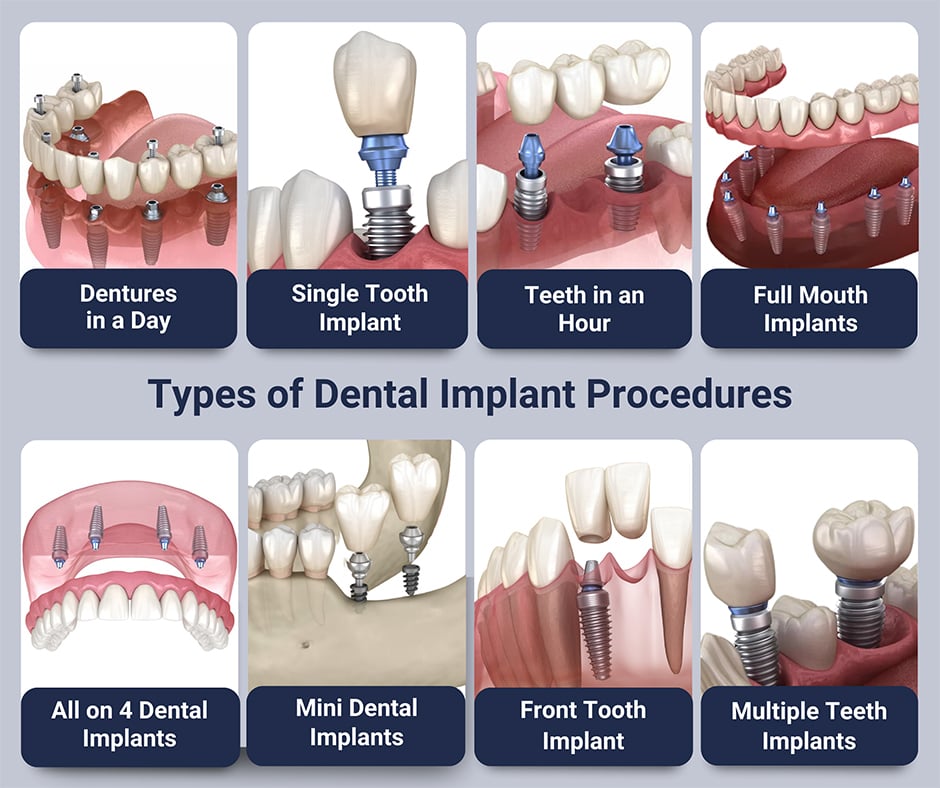Dental Implants Fundamentals Explained
Dental Implants Fundamentals Explained
Blog Article
Some Ideas on Dental Implants You Should Know
Table of ContentsThe Ultimate Guide To Dental ImplantsThe smart Trick of Dental Implants That Nobody is DiscussingThe Best Guide To Dental ImplantsThe Main Principles Of Dental Implants
are clinical tools operatively dental implanted right into the jaw to restore a person's capability to eat or their look. They provide support for man-made (fake) teeth, such as crowns, bridges, or dentures. When a tooth is lost because of injury or condition, an individual can experience problems such as fast bone loss, defective speech, or changes to chewing patterns that result in pain.
Framework of The Dental Implant System selecting oral implants, speak with your dental copyright about the potential benefits and dangers, and whether you are a prospect for the treatment. Points to think about: Your total health is a crucial aspect in establishing whether you are an excellent prospect for dental implants, for how long it will require to recover, and the length of time the implant may remain in place.
Cigarette smoking may impact the recovery procedure and decrease the lasting success of the dental implant. The healing process for the dental implant body may take a number of months or longer, during which time you usually have a momentary abutment in location of the tooth. the dental implant procedure: Carefully follow the dental health directions given to you by your oral provider.
10 Easy Facts About Dental Implants Explained
Implant failing can lead to the need for one more operation to take care of or change the implant system. Brings back the capability to chew Brings back aesthetic appearance Assists keep the jawbone from reducing due to bone loss Maintains the wellness of the bordering bone and gum tissues Aids maintain adjacent (neighboring) teeth steady Improves quality of life Damage to bordering natural teeth during dental implant placement Injury to the surrounding tissues throughout surgical treatment, such as sinus opening Injury during surgical procedure (as an example, crack of surrounding jawbone) Inadequate feature, such as feeling like the teeth do not bite with each other generally An experience that the tooth is loosened or twisting in position resulting from a joint screw loosening up Implant body failure (looseness of the dental implant body) as a result of systemic infection, which may be much more most likely in people with unchecked diabetes mellitus because of local infection in bone and gum tissues supporting the implant body as a result of postponed healing, which might be more probable in individuals that smoke Difficulty cleansing the gums around the dental implant, leading to bad oral hygiene Untreated gum condition Post-surgical tingling due to nerve impingement or damages Constantly inform wellness treatment companies and imaging technicians that you have oral implants prior to any magnetic resonance imaging (MRI) or x-ray procedures.
FDA is not familiar with any type of adverse occasions reported check this site out for MRI or x-ray treatments with dental implants. Dental implants systems are normally made of materials that adhere to worldwide consensus requirements of the International Company for Standardization (ISO) or ASTM International. These standards have details of what makes a risk-free product.
Oral dental implant systems are evaluated according to global agreement standards. Biocompatibility screening, to reveal that bodily call with the tool does not create problems like irritation or sensitive response, is part of the assessment that aids ensure the materials in the dental implant system are safe and do not create unfavorable impacts when implanted in people.

Getting My Dental Implants To Work
Some individuals are not eligible for oral implant surgery. It is for oral specialists to operate people with: acute illnessuncontrollable metabolic diseasebone or soft cells condition or infectionIf these problems are settled, a person can have the surgery. Dental Implants. In, oral specialists refrain from running on people with: If individuals with any of the above undertake dental implant surgery, there is a greater danger of the implant failing
Some people have a jawbone abnormality that stops adequate bone for a dental implant from creating. In such instances, a doctor may require to perform a ridge modification. This involves lifting the gum to reveal the location of warped bone. The doctor will after that use a bone or bone alternative to repair and develop the area.
Dental implant surgery is a personalized procedure. It's not the exact same for every person. However the adhering to offers a general overview of what you can anticipate your dental expert, oral cosmetic surgeon, periodontist or prosthodontist to do: Position the implant surgically. Give you time to recover. Affix the message and final crown, bridge or denture.
Next off, your cosmetic surgeon will carefully web link place the dental implant into your jaw. If your implant is near the front of your mouth, your dentist will make a temporary tooth for you to put on until you recover.
How Dental Implants can Save You Time, Stress, and Money.
During the recovery stage, your jawbone ought to fuse to the dental implant. This procedure can take anywhere from three to 9 months.
When your dental implant heals, your dental practitioner can attach the joint (tiny port blog post) and your final repair (crown, bridge or denture). This normally takes about one hour to complete and might need a second small surgery. You shouldn't feel any type of pain during your dental implant treatment since your provider will utilize medication to numb your gums.
Report this page